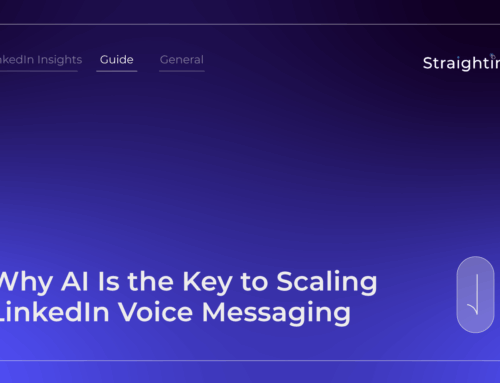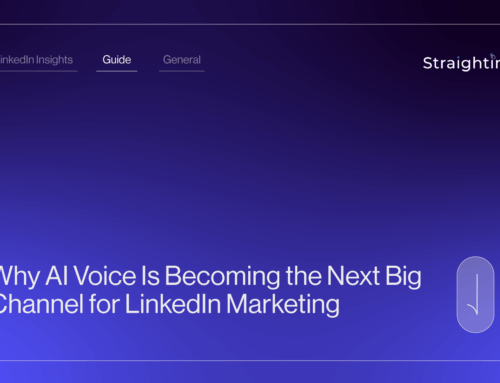LinkedIn is a powerful platform that offers lots of useful marketing opportunities, from organic features to networking. However, many people don’t realise just how powerful LinkedIn can be as an ad platform. What better way to reach your target LinkedIn audience than with targeted ads?
At StraightIn, we understand what makes a successful LinkedIn ad that reaches the right people. After all, LinkedIn is full of potential prospects, so it’s important to leverage all the features it has to offer for your business. Ads are one of those features, and we’re here to guide you through how LinkedIn ads work so you can have them up and running in no time!
How do LinkedIn Ads Work?
LinkedIn Ads is a paid tool that creates ad campaigns on the LinkedIn platform, allowing businesses to reach potential customers on LinkedIn. These ads are often targeted and tailored to a specific audience. This makes it a useful B2B tool and can lead to B2B lead generation, reaching other business leaders who you’ve refined your campaign towards.
LinkedIn has an auction-based system, similar to Google, and uses a pay-per-click or pay-per-impression system. This is why ad quality, proper budgeting and the correct campaign management is so important.
Here are the key steps for getting your ads up and running:
- Choose a campaign objective
- Select your target audience
- Pick your ad format
- Set your budget and schedule
- Measure and track the success of your ads
Below you can find a breakdown of each crucial step to help you properly plan and execute an effective ad campaign.
Choose a campaign objective
As with the start of any marketing campaign, you need to choose an objective. You’d normally pick either awareness, consideration or conversions.
Awareness is to do with creating awareness and attention around your brand. Consideration has the goal of making potential customers consider your brand through website visits and forms of engagement.
Conversions are where the audience performs a desired action, leading to things like website clicks, purchases, job applications, and lead generation.
Select Your Target Audience
LinkedIn Ads provides numerous targeting options to help advertisers refine their target audience and reach the most relevant professionals. This is one of LinkedIn’s most useful features as it creates a refined, specific ad. The options include:
- Demographics: Target users based on characteristics such as age, gender, location, language, and education.
- Job Title and Function: Reach professionals based on their job titles, functions, seniority levels, and industry expertise.
- Company Attributes: Target users based on company size, industry, name, followers, and more.
- Skills and Interests: Reach users based on their skills, interests, groups they belong to, and content they engage with.
- LinkedIn Profile Data: This is how a user uses their profile, such as who and what they engage with, and what content they seem to be interested in.
Ad Formats
LinkedIn has various ad formats to suit your specific campaign goals and audience preferences:
- Sponsored Content: Sponsored content appears on a user’s LinkedIn feed alongside organic content. This type of ad can include text, images, videos, or carousel formats. The appearance of these ads can strengthen brand awareness and recognisability.
- Sponsored Messaging: Also known as InMail ads, these ads appear directly in a user’s LinkedIn inboxes, delivering personalised messages and offers. These messages are often sent to targeted prospects, making them ideal for lead generation and nurturing campaigns.
- Text Ads: These ads appear on the sidebar or top of LinkedIn pages and consist mostly of text. While there’s limited to no imagery involved, text ads can be effective for driving website traffic or generating leads with a clear call-to-action.
Selecting your budget and schedule
The next step is to set your budget and then schedule the ads accordingly. It’s best to test the ads and allocate the budget based on what’s performing best. This eliminates the risk of overspending on one ad campaign that doesn’t actually perform highly.
LinkedIn also has a ‘budget optimisation’ feature, giving more of your budget to higher-performing ads. However, this does take away your agency over ad spend, so find what works best for your ads through close observation.
Next is to schedule your ads. You can decide how long you want to display your ads for, which is useful if you’re running a seasonal or temporary campaign.
Testing and measuring success
A/B testing, also known as split testing, involves comparing two or more versions of a LinkedIn ad to determine which one performs better. For example, two versions of the same ad may have different copy, so you can test which ad copy will resonate more with an audience.
First things first, you need to identify the variables you want to test.
- Ad Creatives: Test different images, headlines, ad copy, and calls-to-action to gauge their impact on engagement and conversions.
- Targeting Criteria: You can see which targeting criteria is more useful to focus on, such as job titles, industries, or geographic locations, to then tailor your ads based on the criteria.
- Ad Formats: There’s the option to compare the performance of different ad formats, such as sponsored content versus sponsored messaging.
Consistent testing and measuring the success of your campaigns allows future changes for improvement. You might notice changes in customer behaviour or gaps of opportunity that can be filled.
Best Practices for LinkedIn Ads
We’ve outlined some tips and best practices for LinkedIn Ads that make sure you really get the most out of your campaign.
- Set Clear Objectives: Clearly defining your campaign objectives is key, whether it’s brand awareness, lead generation, website traffic, or LinkedIn conversions. Once these have been established, you can align your ad’s creative elements and targeting to fit the objective.
- Know Your Audience: LinkedIn’s robust targeting options is such a helpful feature to help reach your ideal audience. Understanding their demographics, job roles, interests, and pain points lets you tailor your messaging effectively.
- Create Compelling Ad Creatives: Visually appealing and engaging copy and visuals is more likely to resonate with your target audience. Use high-quality images, compelling copy, and clear calls-to-action to drive engagement and conversions.
- Optimise for Mobile: Given the increasing use of mobile devices, ensure that your ads are optimised for mobile viewing. Use responsive design, concise messaging, and mobile-friendly landing pages to provide a seamless user experience.
- Monitor and Adjust Campaigns: Monitor your campaign performance metrics and make the necessary adjustments to optimise your campaigns. Testing is crucial- you can test different ad formats, targeting criteria, and bidding strategies to identify what works best for your audience.
- Provide Value: Focus on providing value to your audience through your ad campaigns. Whether it’s educational content, exclusive offers, or thought leadership insights, deliver content that resonates with your audience’s needs and interests.
- Experiment and Innovate: Don’t be afraid to experiment with new ad formats, targeting options, and creative strategies! Keep up to date with industry trends and continuously innovate to stay ahead of the competition.
How StraightIn Can Help With Your LinkedIn Ads
At StraightIn, we specialise in helping professionals and businesses leverage the power of LinkedIn to improve their branding and reach the right audiences. We know the difference a great LinkedIn ad campaign can make, and that’s why we use our advanced tools and expertise to create a successful strategy.
If you’ve got a question about B2B lead generation or content marketing strategies tailored for LinkedIn, get in touch with us today!







